#aztec empire
Text
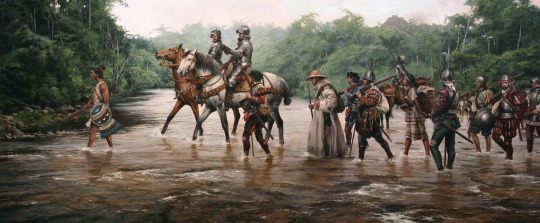
The March to Tenochtitlan by Augusto Ferrer-Dalmau
#hernán cortés#conquistador#art#augusto ferrer dalmau#conquistadors#tenochtitlan#tenochtitlán#mexico#spanish#spain#aztec#aztecs#mexica#mesoamerica#bartolomé de olmedo#pedro de alvarado#americas#history#european#age of discovery#age of exploration#explorer#spanish empire#conquest#aztec empire#expedition#river#friar#knight#priest
76 notes
·
View notes
Text

Olrox is the most interesting character in the whole cast of Castlevania Nocturne (at least until we see what Alucard will do in season two).
His understanding of human nature and the fact that he doesn’t want to attack ‘peasants’ but rather prefers ‘drink blue blood’ leaves me alone with the thought that he is hundreds of years ahead of his time. Many people think that us latinoamericanos didn’t have any type of resistance, but trust me when I say, that’s far from the truth; Olrox is the best way of putting it, he understands the thinking of colonialists and also understands the importance of being silent and letting the other speak, he doesn’t show his cards until the counterpart is vulnerable, he does the same that Native American revolutions did back then.
AND I LOVE HIM FOR THAT.
#castlevania: nocturne#castlevania netflix#castlevania olrox#castlevania nocturne#castlevania fanart#castlevania#castlevania mizrak#olrox fanart#olrox matters so much#olrox/mizrak#mizrak x olrox#olrox#aztec vampire#aztec empire#Castlevania nocturne fanart#gay vampires
1K notes
·
View notes
Text

Earthquake Reveals Aztec Snakehead Beneath Mexico City
Researchers are conserving a rare snakehead from the Aztecs that still retains its painted colors from hundreds of years ago.
An earthquake last year revealed a big surprise beneath a law school in modern-day Mexico City: a giant, colorful snakehead from the Aztec Empire.
The snakehead dates back more than 500 years, to when the Aztecs controlled the area, which at the time was part of the flourishing capital of Tenochtitlan. The sculpture was discovered after a magnitude-7.6 earthquake struck Mexico City on Sept. 19, 2022; the seismic event caused damage and changes in the topography, revealing the snakehead beneath a building that was part of a law school at the National Autonomous University of Mexico, Mexico's National Institute of Anthropology and History (INAH) said in a Spanish-language statement.
The Aztecs built temples and pyramids and worshipped a number of deities, including Quetzalcoatl, who was often depicted as a snake. However, it's unclear if this sculpture depicts him, the archaeologists said.
The sculpted snake is 5.9 feet (1.8 meters) long, 2.8 feet (0.85 m) wide and 3.3 feet (1 m) high, and it weighs about 1.3 tons (1.2 metric tons), the INAH said. Several colors — including red, blue, black and white — are preserved on the sculpture.

Color was preserved on about 80% of the sculpture's surface. To keep it preserved, an INAH team lifted the snakehead out of the ground with a crane and constructed a humidity chamber around the sculpture. This chamber allows the sculpture to lose humidity gradually, with its color being preserved, María Barajas Rocha, a conservationist with the INAH who worked extensively on the sculpture, said in the statement.
While other snakehead sculptures have been found at Tenochtitlan, this one is particularly important for its preserved colors, said Erika Robles Cortés, an archaeologist with the INAH.

"Thanks to the context in which this piece was discovered, but above all, thanks to the stupendous intervention of the restorers-conservators led by Maria Barajas, it has been possible to stabilize the colors for its preservation in almost all the sculpture, which is extremely important, because the colors have helped us to conceive pre-Hispanic art from another perspective," Robles Cortés told Live Science in an email.
The sculpture's "sheer size is impressive, as well as its artistry," but the survival of the colors is remarkable, said Frances Berdan, a professor emeritus of anthropology at California State University, San Bernardino who was not involved with the excavation. "The survival of black, white, red, yellow, and blue paints is particularly interesting — one gains a good image of the visual impact of such sculptures as they were arrayed about the city center," Berdan said in an email.

In addition to its preserved colors, the snakehead's size is notable, said Bertrand Lobjois, an associate professor of humanities at the University of Monterrey in Mexico who is not involved in the excavation. The "first time I saw this serpent head, I was dazzled by its dimensions," he said in an email.
Lobjois also praised the conservation work that allowed the colors to survive, noting that "the conservation process allows us to appreciate the naturalistic approach of figuration" the Aztec artists used.
This work is ongoing and will continue at the site into next year.
By Owen Jarus.
#Earthquake Reveals Aztec Snakehead Beneath Mexico City#National Autonomous University of Mexico#Quetzalcoatl#sculpture#stone sculpture#ancient artifacts#archeology#archeolgst#history#history news#ancient history#ancient culture#ancient civilizations#aztec culture#aztec history#aztec mythology#aztec gods#aztec empire#aztec art
518 notes
·
View notes
Text

✨ NEW EPISODE ✨
039. Aztec Empire with Paul Guinan
Paul Guinan, along with illustrator David Hahn, produce Aztec Empire, a historic webcomic about the conquest of Tenochtitlan that is free to read at Paul’s website bigredhair.com. Currently, Aztec Empire is up to 9 episodes with Cortes and his men currently in Veracruz. Aztec Empire has been nominated by both the Ringo and Eisner Awards for Best Digital Comic. In addition to Aztec Empire, Paul is a founding member of Helioscope Studio and is co-creator of other works such as Cargonauts, Heartbreakers, Boilerplate: History’s Mechanical Marvel, Frank Reade: Adventures in the Age of Invention, and the DC Comic Chronos.
143 notes
·
View notes
Text
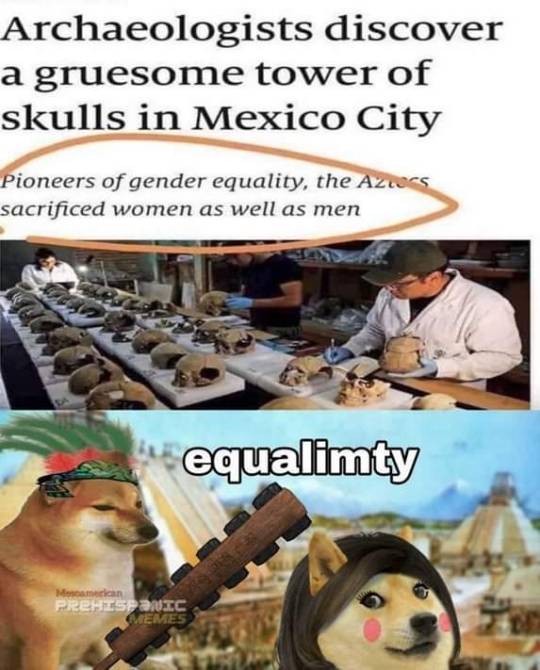
#meme#memes#shitpost#shitposting#humor#funny#lol#satire#funny memes#funny humor#funny meme#comedy#dark humor#journalism#journo#stupid#aztecs#aztec empire#prehispanic#irony#joke#parody#archaelogy#mexico city
73 notes
·
View notes
Text
Flag of the Aztec Empire
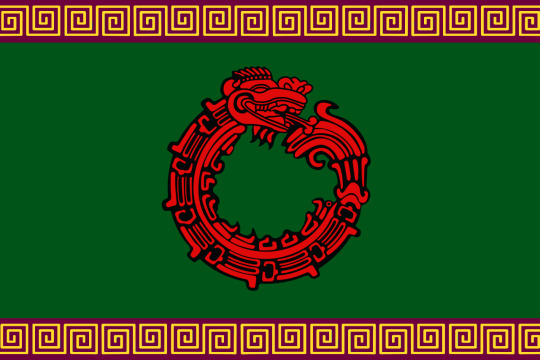
This is the flag of the Aztec Empire. It comes from a world where the Aztecs defeated Cortez and his troops. Smallpox still ravaged the Aztecs, but due to the more limited exposed they were able to recover by the time the Spanish sent additional expeditions. It soon become obvious that the empire would need to reform itself if it was going to survive the European colonization of the Americas.
The debate around these reforms leads to social upheavals and rebellions. The empire ultimately survived, but with a Tlaxcalan ruling dynasty. The Tlaxcalans, always one of the more reform minded peoples of the empire, set about instituting serious reforms.
The first reform was the structure of the empire. The provinces became much more centralized in their organization. The emperor still ruled over all, but each province sent a group of delegates to represent the needs of the province in a special council in Tenochtitlan. The priests and priestesses also began to slowly phase-out human sacrifice from the traditional religion of the Aztecs. Trade relations were established with multiple European nations both to gain access to European technology and to play the various powers off of each other.
For the next few centuries the Aztecs would be prosperous and would have good relations with their neighbors. They provided troops to the Federated Provinces of Cabotia during their rebellion against the British Empire. To this day the two nations remain close allies to this day. The Aztecs also maintained good relations with the Incan Empire, which also managed to avoid European conquest. The Aztecs went on to expand their territory to stretch from the American Southwest to the tip of Panama, and even managed to nab a few islands of the Caribbean.
The next major wave of reforms occurred during the 19h century. The Aztecs, much like Japan during the Meiji Restoration, underwent a Westernization process. Though from the Aztecs points of view the term would more accurately be Easternization. Industrialization began to take off, and Western clothing and customs were slowly introduced to improve relations with the great powers of Europe. However, the Aztecs did not completely turn their backs on their traditional culture. Aztec clothing still remains very colorful and incorporates many traditional designs, and nose rings are still somewhat popular for men and women. More traditional clothing is usually reserved for special ceremonies and occasions, such as religious festivals and the emperor's birthday.
The Aztecs also still worship their old gods, and many temples and shrines can be found throughout the empire. On the other hand, secularism is on the rise, and many people only perform the old rituals out of habit and tradition. What was once an empire imfamous for its bloodlust is today known as a thriving center of technology and innovation.
The flag features the colors red and green, which are traditional Aztec colors. The maze pattern is a common feature in Aztec artwork. The red snake is the feathered serpent god Quetzalcoatl, god of the winds and one of the most important gods in the Aztec pantheon.
Link to the original flag on my blog: https://drakoniandgriffalco.blogspot.com/2016/11/flag-of-aztec-empire.html?m=0
#alternate history#alternate history flag#alternate history flags#flag#flags#Aztec Empire#aztec#Aztecs#Nahuas#Nahua#Mexica#Mexico#indigenous#indigenous people#Triple Alliance#Tlaxcala#Tlaxcalans#Flag of the Aztec Empire#alt history#vexillology
90 notes
·
View notes
Text



#kemetic dreams#brownskin#brown skin#asian culture#east asians#asian american#aztec#Nahuatl#tenochtitlan#texcoco#tlacopan#aztec empire#aztlan
203 notes
·
View notes
Text


Quetzal Feathered Headdress from Mexico dated around 1515 on display in the Weltmuseum in Vienna, Austria
The first known reference to this feathered headdress in Europe occurs in 1596, as the "Moorish Hat" in the inventory of the collection of Archduke Ferdinand II of Tyrol at Schloss Ambras. Ferdinand collected objects of cultural signigficance for his castle to make a museum that was part of his efforts to promote the Renaissance in the Empire.
Before this it was thought to have been the headdress of Emperor Moctezuma Xocoyotzin II of the Aztec Empire however the provenance of this is uncertain. This is due to it not matching any other illustrations of such headdresses.
The headdress arrived in Vienna in the early 19th century. During a restoration in 1878, feathers and metal elements were supplemented. Since at that time it was assumed that the object was originally a type of standard rather than a three-dimensional piece of headgear, it was flattened to fit that image. Due to it's fragility there can be no further interventions and this is the reason given by the museum as to why it cannot be repatrioted back to Mexico. Activist, lecturer, writer and dancer Xokonoschtletl Gómora has campaigned for it's return to Mexico.
Photographs taken by myself 2022
#archaeology#art#history#aztec empire#mexican#mexico#fashion#16th century#weltmuseum#vienna#barbucomedie
82 notes
·
View notes
Text
Please reblog for a bigger sample size!
If you have any fun fact about the Aztec Empire, please tell us and I'll reblog it!
Be respectful in your comments. You can criticize a government without offending its people.
#aztec empire#aztec#Ēxcān Tlàtōlōyān#north america#latin america#country polls#historical polls#polls
13 notes
·
View notes
Text
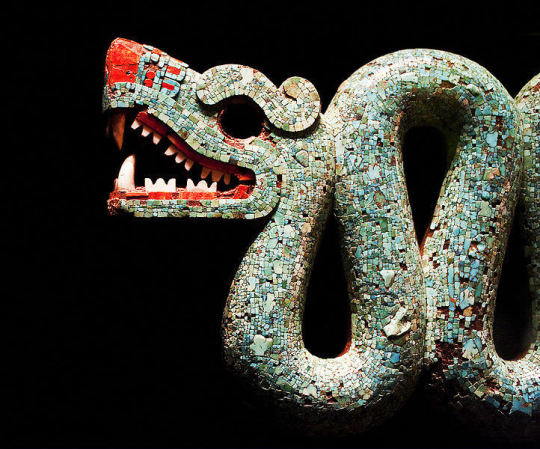





THE Aztecs of northern Mesoamerica (c. 1345 and 1521 CE) worshipped some of the weirdest, most fantastic and downright scary gods seen anywhere in history. The Aztec civilization and the empire it created revolved around winning special favour with these gods in order to ensure a measure of balance in nature, the continuance of human life and even the daily rising of the sun itself. In this collection we examine 15 gods in detail, looking at the mythology they were involved in and their particular associations such as their special days, numbers and animals. Here are all the major gods from mighty Huitzilopochtli, Hummingbird of the South, and his links with war and eagles to mischievous Xochipilli, the Flower Prince, linked to summer, butterflies and poetry.
The top 15 Aztec gods were:
Huitzilopochtli - the supreme god of the Sun and war.
Tezcatlipoca - the ever-present creator god and patron deity of warriors.
Tlaloc - god of rain, water, lightning, and agriculture.
Quetzalcóatl - god of winds and rain and the creator of humanity.
Coatlicue - the earth-mother goddess.
Tlaltecuhtli - the earth goddess associated with fertility.
Mictlantecuhtli - ruler of the underworld
Tonatiuh - god of the present and fifth Sun.
Coyolxauhqui - goddess of the Moon.
Mixcoatl - god of hunting, the Milky Way, and the stars
Ehecatl - god of air and winds.
Tlahuizcalpantecuhtli - god who represented a menacing aspect of Venus.
Xiuhtecuhtli - god of fire.
Xipe Totec- god of spring, seeds, and planting.
Xochipilli - god of summer, flowers, love, and dancing.
Read more here
341 notes
·
View notes
Photo

Aztec Empire. Viceroyalty of New Spain. Mexico
133 notes
·
View notes
Text

As a LatinAmerican student let me tell you something about Olrox, I love him and everything he represents.
Did he killed Julia Belmont? Yes, and she had it coming , let me explain; You don’t go out on a literal civil war without context on what’s going —on and who’s attacking who and most importantly why— take the side that looks like you, just to essentially killed the last hope of protection the other side has —Let’s remember that Belmont knew about the tale of vampires that could be friendly or neutral at worst /aka Alucard/ she could have spoken to the natives or the slaves to know why this was happening, but she didn’t /I doubt she did at least/— then make unfair decisions about who is evil and deserves to die.
(She might have KNOWN what was going on, since –in my understanding– she was living there for A GOOD WHILE, so she either didn’t care or was oblivious enough to pass it out.)
Olrox is literally the best thing to ever happen to me in so long, the lore behind him and the profound sense of cultural connection I feel with him is something I haven’t felt in a long time, I can feel his rage and his intense feeling of disgust at the idea of colonialism.
As a kid most of us were always told that colonialism was good for us, that we were savages before and now “we’re better bc we have technology”, but guess what, we had our technology back then, we had a way of living and a good thing going on. Was it perfect? No. But it was way better that the hell that was forced into us, the sickness and the cultural hatred that influenced us into submitting our culture and beliefs, THAT WASN’T A GOOD THING.
Olrox has every right and reason to do what he does. Fight me in the comments about it.

#castlevania: nocturne#castlevania netflix#castlevania olrox#castlevania nocturne#castlevania fanart#colonialism#olrox/mizrak#olrox matters so much#Olrox fanart#Aztec vampire#castlevania mizrak#julia belmont#ritcher belmont#quetzalcoatl#aztec empire
205 notes
·
View notes
Text


The Aztec Death Whistle ‘The Most Terrifying Sound in the World’
For those who want to celebrate Halloween like it’s 1399: Scientists are sending shivers down the internet’s collective spine by recreating an ancient “Aztec Death Whistle” that’s said to emit the “most terrifying sound in the world.”
The macabre kazoo is detailed in a new video produced by the Action Lab, a group of proud internet nerds who specialize in mind-bending experiments.
“The sound that the death whistle makes innately strikes fear into your heart,” intones presenter James J. Orgill in the clip while holding a 3D-printed version of the instrument.
The Brigham Young University engineering grad then plays an audio clip of the scream machine, which evokes a bloodcurdling, bansheelike shriek resembling a sound effect from a haunted house attraction. (We dare you not to jump!)
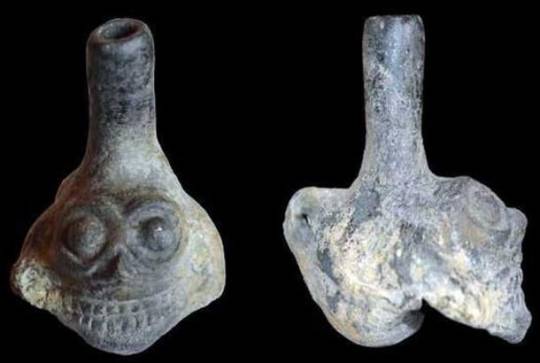
Orgill points out that this is not a “human scream” but rather the sound emitted by the replica of a skull-shaped artifact originally discovered in Mexico City in 1999 by archaeologists.
It was reportedly found clutched in the hand of a headless skeleton in a temple dedicated to the wind god Ehecatl — one of many sites where the Aztecs conducted human sacrifices.
Initially thinking it was a toy, per Orgill, scientists didn’t blow into it until 15 years later, whereupon it emitted a terrifying sound.
“‘It was a startling discovery because it sounded like a screaming human,” said the burgeoning YouTube star, who dubbed it the “most terrifying sound in the world.”


The Aztecs were able to create this nightmarish noise by modeling the death whistle after the human larynx.
When the user blows into the instrument, the wind divides in two, producing oscillating sound waves that bounce around a large chamber before leaving via a second hole.
While the purpose of the instrument remains unclear, experts have several theories, with some believing this fright flute was used to scare enemies in battle.
Others postulate that the whistle was a defense talisman used to ward off evil spirits during a sacrificial victim’s journey to the afterlife.
In order to resurrect this symphony of screams for our listening “pleasure,” Orgill blew into different Tim Burton-esque whistles that were 3D-printed by US tech firm HeyGears.
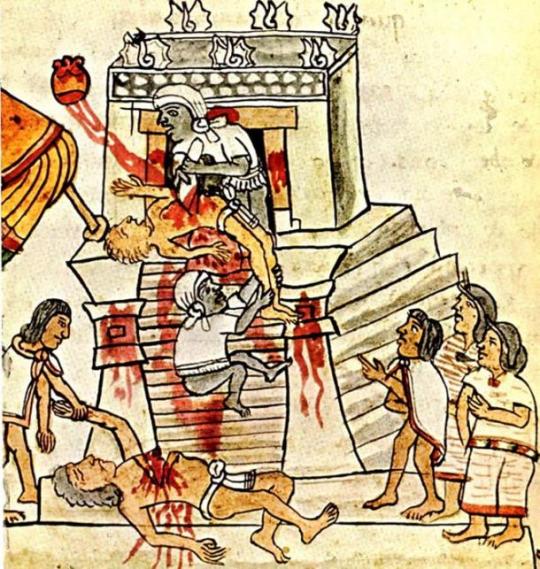


All told, they made the raptor larynx from “Jurassic Park” sound like a kazoo.
No 3D printer, no problem: Interested parties can buy their death whistles on Amazon, which offers duplicates made of materials ranging from resin to carbon fiber.
Many advertise how closely their decibels match that of the most bone-chilling human screams.
By Ben Cost.
#Aztec Death Whistle#The Aztec Death Whistle ‘The Most Terrifying Sound in the World’#Tlatelolco#mexico city#the wind god Ehecatl#ancient artifacts#archeology#archeolgst#history#history news#ancient history#ancient culture#ancient civilizations#aztecs#aztec history#aztec mythology#aztec culture#aztec gods#aztec empire#aztec art
196 notes
·
View notes
Text
Yesterday Catherine and I recorded an episode of Mesoamerican Studies On-Air with Paul Guinan, the creator of the Aztec Empire graphic novel/webcomic. The episode should be out in two weeks. But in the mean time, please check out his wonderfully illustrated and researched comic. It will make his interview so much more exciting.
77 notes
·
View notes
Text

#meme#memes#shitpost#shitposting#humor#funny#lol#satire#funny memes#funny humor#funny meme#comedy#aztecs#anti authoritarian#sarcasm#irony#joke#parody#dark humor#aztec empire#prehispanic
39 notes
·
View notes
Photo

America: Being the Latest, and Most Accurate Description of the New World (1671)
#america#north america#south america#central america#west indies#the new world#1492#aztec empire#inca empire#american indians
71 notes
·
View notes